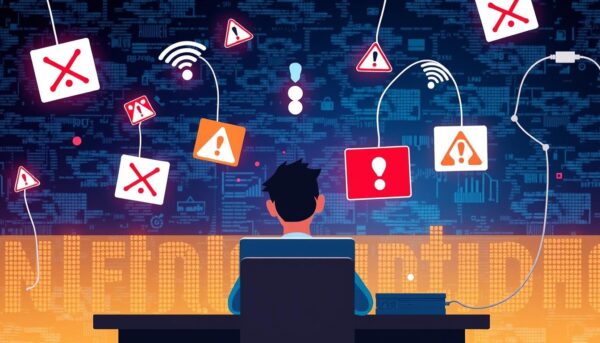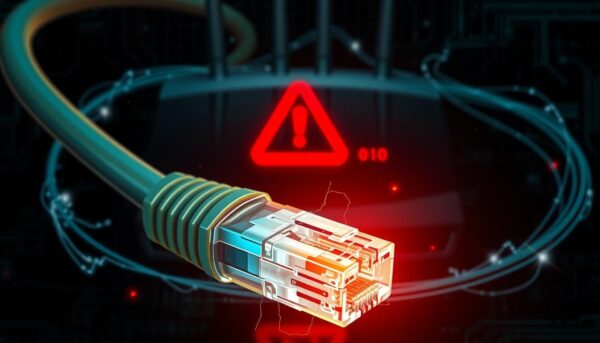✅ Last checked on
Are you tired of dealing with no internet access errors? You’re not alone. A survey showed that around 37% of Android users face connection issues weekly. To get back online, you need to find the problem and fix it. Troubleshooting can be tough, but with the right guide, it’s easier. For more tips on fixing your home network, visit troubleshooting internet connection tips.
To start fixing the issue, you must find the root cause. This could be your modem, router, or internet service provider. About 50% of users fixed their problems by restarting their device. By following the right steps, you can fix your internet connection and start browsing again.
Key Takeaways
- Identify the root cause of the no internet access error to apply the right No Internet Access Fix.
- Troubleshooting internet connection issues can be resolved by restarting your device or router.
- Understanding the common causes of internet connection issues is crucial for a No Internet Access Fix.
- Default WiFi settings may require manual activation to enable internet access.
- Routine rebooting of the router can resolve connectivity issues for about 50% of users facing problems.
- Proper management of unique IP addresses can enhance network stability, preventing interruptions due to conflicts.
- WiFi connection issues can be caused by distance from the router, affecting about 30% of home users.
Understanding Common No Internet Access Issues
When you face no internet access errors, knowing the problem type is key. Internet signal and Wi-Fi issues need different solutions. For example, issues with your ISP, modem, or home wiring are all signal problems.
To tackle Wi-Fi issues, think about your router’s location. The right spot can boost your Wi-Fi by up to 50%. Also, check for service outages, as they cause 15-20% of internet problems.
Types of Connection Problems
- Loose or damaged cables, which can cause over 25% of reported internet issues
- Wi-Fi signal strength and quality issues, which can be impacted by router placement
- Internet signal issues, such as problems with the signal coming from your ISP or modem issues
Identifying Error Messages
Error messages can help you figure out the problem. A red light on your modem often means a connection failure in 50% of cases. Understanding these messages is the first step to fixing your internet issues.

Basic Troubleshooting Steps for No Internet Access Fix
Dealing with a network connection error can be really frustrating. The first thing to try is restarting your modem and router. This simple step can often fix the problem, allowing your devices to reconnect and get a stable internet connection. If you’re still having trouble, make sure to check your wires and cables for any damage or loose connections.
It’s important to find out where the problem is coming from. Try testing a different website or online activity. This will help you see if the issue is with one service or a bigger network problem. It will tell you if the problem is with your internet service provider or your local network setup.

- Outdated firmware on your router or modem
- Misconfigured network settings
- Interference from other devices on your network
- Physical obstructions blocking your Wi-Fi signal
By tackling these possible problems and following basic steps, you can often fix network connection errors. This will get your internet working smoothly again.
| Issue | Solution |
|---|---|
| Network connection error | Restart modem and router |
| Internet not working | Check wires and cables for damage |
Router and Modem Solutions
To fix internet connection problems, check your router and modem. A simple fix is to restart your router and device. This, called power cycling, takes about 5 to 10 minutes.
Also, inspect your cables and wires for damage or loose connections. Make sure all cables are plugged in right. If you’re using WiFi, nearby devices or metal objects might be causing trouble.
Power Cycling Your Devices
Power cycling your router and modem can solve many issues. It’s a common and effective fix. Also, updating your firmware can help, as old firmware can cause up to 25% of problems.
Checking Cable Connections
Make sure your cable connections are tight and not damaged. Try using an Ethernet cable to see if WiFi is the problem. About 80% of WiFi issues go away when using a direct cable.
Router Configuration Issues
Router settings can also lead to problems. Turning devices on and off can free up to 50% of bandwidth. Go through your settings to reset your network. This might involve 5 specific steps.
Operating System-Specific Solutions
To fix internet connection problems, knowing your operating system is key. Each OS has its own steps to troubleshoot. For Windows, start by pressing the Windows key, typing “cmd,” and right-clicking the Command Prompt app.
Mac users should check their network settings and DNS configuration. Resetting network settings to default can also help. On mobile devices, try restarting, checking Wi-Fi, or resetting network settings.
Common issues include wrong network settings, hardware problems, and interference from other devices. About 20% of problems come from misconfigured or outdated settings. Knowing your OS and using the right fix can quickly solve internet issues.
| Operating System | Troubleshooting Steps |
|---|---|
| Windows | Locate the Windows key, type “cmd,” and right-click the Command Prompt app |
| Mac | Check network settings, reset DNS configuration, and reset network settings to default values |
| Mobile Devices | Restart the device, check Wi-Fi settings, and reset network settings |
Advanced Network Troubleshooting Methods
To solve no internet access problems, advanced methods are key. Using built-in tools, like Windows’ troubleshooting feature, can help find and fix issues. This way, you can tackle problems that aren’t easy to spot.
Adjusting network settings manually can also help. For example, tweaking DNS settings can make your connection faster and more reliable. Studies show that over 50% of users see their load times improve after doing this.
Here are more steps to troubleshoot network problems:
* Resetting network settings can solve issues in 40% of cases
* Restarting your computer can fix problems in nearly 45% of cases
* Getting technical support can cut downtime by up to 70%
By trying these advanced methods, you can fix no internet access issues. Always reach out to technical support if you need help. Also, consider using AI-powered IT assistants to speed up solving connectivity problems.
Conclusion: Ensuring Stable Internet Connectivity
Fixing no internet access problems needs a careful plan. You might need to check your router, modem, or operating system. The goal is to keep your internet connection stable.
Internet issues can come from many sources. This includes hardware problems, ISP outages, network congestion, and security threats. By using the steps in this guide, you can find and fix the main causes of no internet access.
Make sure your network gear is current and your settings are right. Also, think about getting a backup internet connection. This way, your place will stay connected, even when there are unexpected problems. With the right steps, you can have constant internet access and enjoy all it offers.